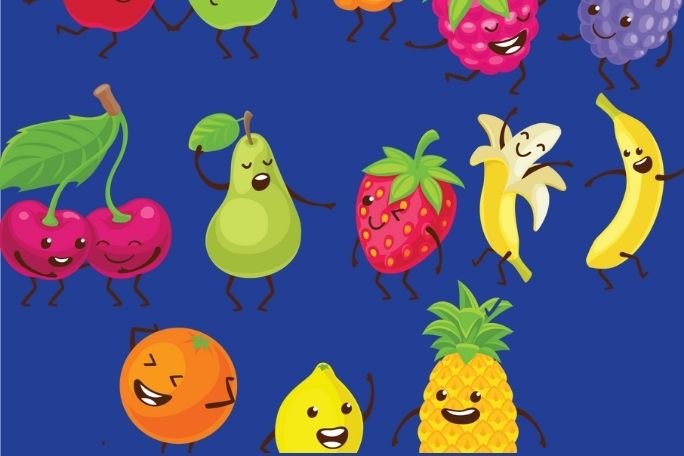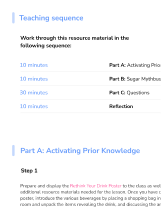Lesson summary
In this lesson, we get active, moving and grooving along to music. Students explore the different ways we can be healthy, focusing on fabulous food, wonderful water, moving, grooving and restful recharge. The students make a ‘Healthy Me’ poster, showing all of the ways you can reduce added sugar every day, drink more water and get plenty of rest. The posters can be used as a display to share with others.
Learning Intentions:
Students will...
- learn how we can make healthy choices
- learn how to share the message of sugar contained in diets
Success Criteria:
Students can...
- explain why it is important to move our body
- share a message about healthy choices
Lesson guides and printables
Curriculum links
Select your curriculum from the options below.
Lesson details
Curriculum Mapping
Australian Curriculum content description:
Year 1 & 2, Health and Physical Education
- Identify actions that promote health, safety and wellbeing (ACPPS006)
- Examine health messages and how they relate to health decisions and behaviours (ACPPS021)
Relevant parts of Year F-2 achievement standards:
Australian Foundation: By the end of Foundation Year, students recognise how they are growing and changing. They identify and describe the different emotions people experience. They identify actions that help them be healthy, safe and physically active.
Australian Year 1 and 2: By the end of Year 2, students describe changes that occur as they grow older. They recognise how strengths and achievements contribute to identities. They identify how emotional responses impact on others’ feelings. They examine messages related to health decisions and describe how to keep themselves and others healthy, safe and physically active. They identify areas where they can be active and how the body reacts to different physical activities.
This lesson is part of the wider unit of work SugarByHalf – Lower Primary – Sugar and Healthy Kidneys
Time required: 90 mins
Level of teacher scaffolding: Medium – Lead lesson discussions and assist with activities
Keywords: human body, movement, sugar, healthy food choices
To view our NZ Curriculum alignment click here
Resources Required
- Device capable of presenting a video to the class
- 1 sheet of poster paper for each student (could use Body Maps from lesson 1)
- Drawing materials – coloured pencils, crayons or marker pens
Additional Info
These lessons were developed in partnership with SugarByHalf and Filter Your Future. Filter Your Future guides children towards positive lifestyle choices to reduce the impact of preventable chronic diseases in future generations. Not many people know that type 2 diabetes and high blood pressure account for half the chronic kidney disease cases in Australia. When children learn about the function of the kidneys to clean the blood, how it balances water and salts, and remove waste from the body, they develop an understanding which motivates them to follow a healthier lifestyle.
Filter Your Future's vision is that young students are provided with evidence about the global health epidemic of weight-related chronic diseases and are empowered to make better lifestyle choices for a healthier future.
People who carry the burden of chronic disease all share the same vision for the future. They want their children and grandchildren to have a healthier future than themselves. By providing children with early awareness, prevention and health promotion, we provide pivotal education about wise choices to prevent chronic disease before poor lifestyle choices become unhealthy habits. Members of the Dialysis and Transplant Association of Victoria, Inc. (D.A.T.A.) and FILTER YOUR FUTURE® believe that this project will benefit our future generations and our nation.
Guardians of the Gums was written by Bee Healthy Stories; if you would like to see more of their stories, head to Bee Healthy Stories.
SugarByHalf promotes action to reduce sugar-related diseases so that we can live better, stronger and healthier lives.
Their message is simple: to reduce added sugar consumption by half. Eating too much added sugar is a key driver of serious health problems including obesity, type 2 diabetes, heart disease, tooth decay, dementia and mental health conditions. A poor diet also puts children behind their peers, affecting brain development, sleep and ability to learn. Poor diet choices ultimately mean that this generation of children could be the first in modern history to live shorter lives than their parents.
Much of the added sugar in our diet comes from the processed foods and drinks we consume. On average, we consume 14-16 teaspoons of added sugar per day. Teenagers consume more than 20 teaspoons per day. The World Health Organisation says we should limit our daily added sugar intake to 6 teaspoons for good health. To put that in perspective, there are 4 grams of sugar in one teaspoon. If something has 20 grams of sugar, that's 5 teaspoons of sugar.
This English lesson focuses on developing the skills and knowledge students need to critically consider messages about food and drink they are exposed to, thereby equipping them to be able to make healthy choices.
Talking about Health:
- Be mindful of students who may experience weight stigma. Some students may be sensitive to conversations around weight, body size or shape. Terms including obesity, weight issues, weight-problem and fat can be stigmatising for some people because they assign blame. It is important to note individual preferences around language vary. Research has shown using the terms ‘weight’, ‘weight gain’, ‘healthy weight’, ‘unhealthy weight’, and ‘high BMI’ are preferred as better alternatives.
- Be mindful about how you use the word ‘diet’. We recommend focussing students on the positive impacts of healthy nutrition and healthy lifestyles which help us to have stronger bodies and minds, feel good and sleep well.
- Steer students away from any focus on appearances by communicating that appearance does not determine your worth. We recommend the fact sheets from the Butterfly Foundation on body image tips.
- Avoid using labels such as obese or diabetic. Refer to people living with diabetes, people living with cancer, people with high BMI etc.


Welcome back!
Don't have an account yet?
Log in with:
Create your free Cool.org account.
Many of our resources are free, with an option to upgrade to Cool+ for premium content.
Already have an account?
Sign up with:
By signing up you accept Cool.org's Terms and Conditions(Opens in new tab) and Privacy Policy(Opens in new tab).